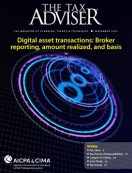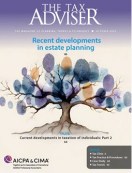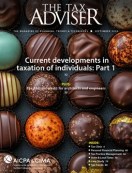Specific requirements apply to the adequate disclosure of transactions on a gift tax return.
Gift Tax
Final regs address taxes on gifts to taxpayers from ex-U.S. citizens, residents
The final regulations implement Sec. 2801, added to the Code in 2008, and follow up on proposed regulations issued 10 years ago.
Fact sheet addresses taxability of crowdfunding distributions
The IRS said that crowdfunding distributions may be included in the gross income of the person receiving them, depending on the facts and circumstances of the distributions.
Supreme Court: Insurance proceeds increase corporation’s estate tax value
In a unanimous decision, the Supreme Court holds that life insurance proceeds a corporation receives to fund a share redemption agreement increases the corporation’s estate tax value.
Recent CCA raises concerns for irrevocable grantor trust modifications
A Chief Counsel Advice memo holding that adding a tax reimbursement clause to an irrevocable grantor trust will constitute a taxable gift by the beneficiaries to the grantor raises a host of questions that taxpayers and advisers should consider before modifying a trust.
Wealth transfer strategies amid shifting interest rates
Advisers must consider changes in interest rates when recommending the most advantageous estate and gift planning vehicles and strategies.
Recent developments in estate planning: Part 2
This second installment of an annual update on trust, estate, and gift taxation covers gift and generation-skipping transfer taxation plus inflation adjustments and legislative proposals in the president’s proposed budget for fiscal 2024.
Recent developments in estate planning: Part 3
In this third installment of an annual update on trust, estate, and gift taxation, the topics include generation-skipping transfer tax, trusts, private foundations, selected inflation-adjusted amounts, and the president’s and Treasury’s proposed law changes affecting trusts, estates, and gifts.
Recent developments in estate planning: Part 2
In this second installment of an annual update on trust, estate, and gift taxation, the topics include split-dollar life insurance arrangements, indirect gifts, formula clauses in transfers of limited partnership interests, valuation discounts, and grantor retained annuity trusts.
IRS proposes to amend estate and gift tax basic exclusion regs.
Exceptions to the special rule allowing the temporarily higher basic exclusion amount to apply to gifts credited against estate tax.
10 common Form 709 mistakes
While it may take some finesse to report the most complicated transactions on Form 709, you do
not have to be a gift tax specialist to be aware of 10 common return preparation mistakes.
Indirect gift tax considerations for 2021
It is important to consider some of the less-obvious gifts when you are advising clients who are intent on using up their full $11.7 million basic exclusion amount before the end of the year.
Recent developments in estate planning: Part 1
This first part of this annual update focuses on trust and gift tax issues.
AICPA recommendations on Q1 estimates and 2020 Form 709 extensions
The AICPA has released some recommendations for practitioners concerning various issues that have arisen due to the postponement of the April 15 tax deadline for individuals.
Recent developments in estate planning: Part 1
This first part of the annual update covers trust and gift tax issues, including regulations explaining deductions permitted for trusts and estates after the TCJA eliminated miscellaneous itemized deductions for individuals.
Gift and GST returns added to postponed tax and filing deadlines
The IRS postponed the payment and return filing requirements for gift and generation-skipping transfer taxes due April 15 to July 15, matching prior postponements granted to federal income taxes and returns.
Seize the increased basic exclusion amount
Taxpayers can obtain unique benefits when it comes to gift and estate tax planning by using trusts and taking advantage of applicable valuation conventions.
IRS rules eliminate estate and gift tax clawback
The IRS issued final regulations that reconcile the current higher exclusion for the estate and gift tax unified credit amount in effect under the TCJA with the lower unified credit scheduled to go into effect in 2026.
Final regs. eliminate estate and gift tax clawback
The IRS issued final regulations that reconcile the current higher exclusion for the estate and gift tax unified credit amount in effect under the law known as the Tax Cuts and Jobs Act with the lower unified credit, which is scheduled to go into effect in 2026, eliminating a possible future clawback of the higher exclusion amount.
Recent developments in estate planning: Part 2
This second part of a two-part article covers court cases, proposed regulations, and other IRS guidance issued over the last year on gifts and estates.
TAX PRACTICE MANAGEMENT
2025 tax software survey
AICPA members in tax practice assess how their return preparation software performed during tax season and offer insights into their procedures.














